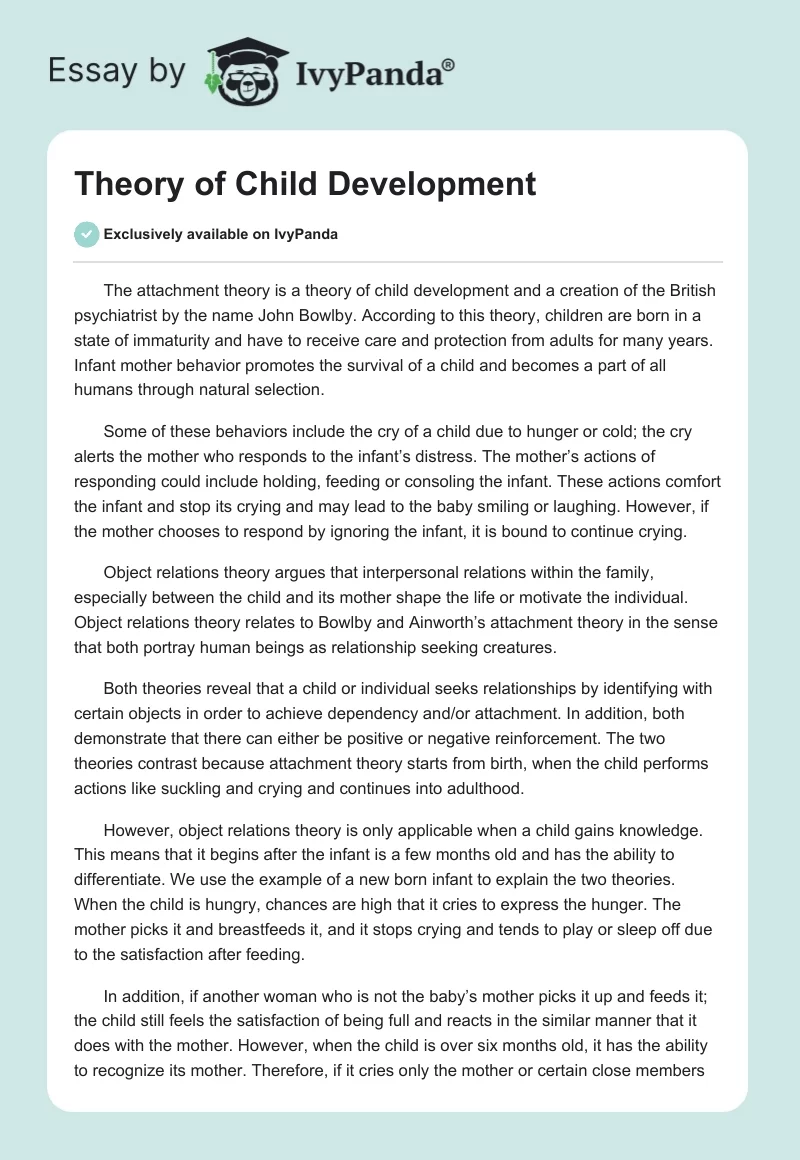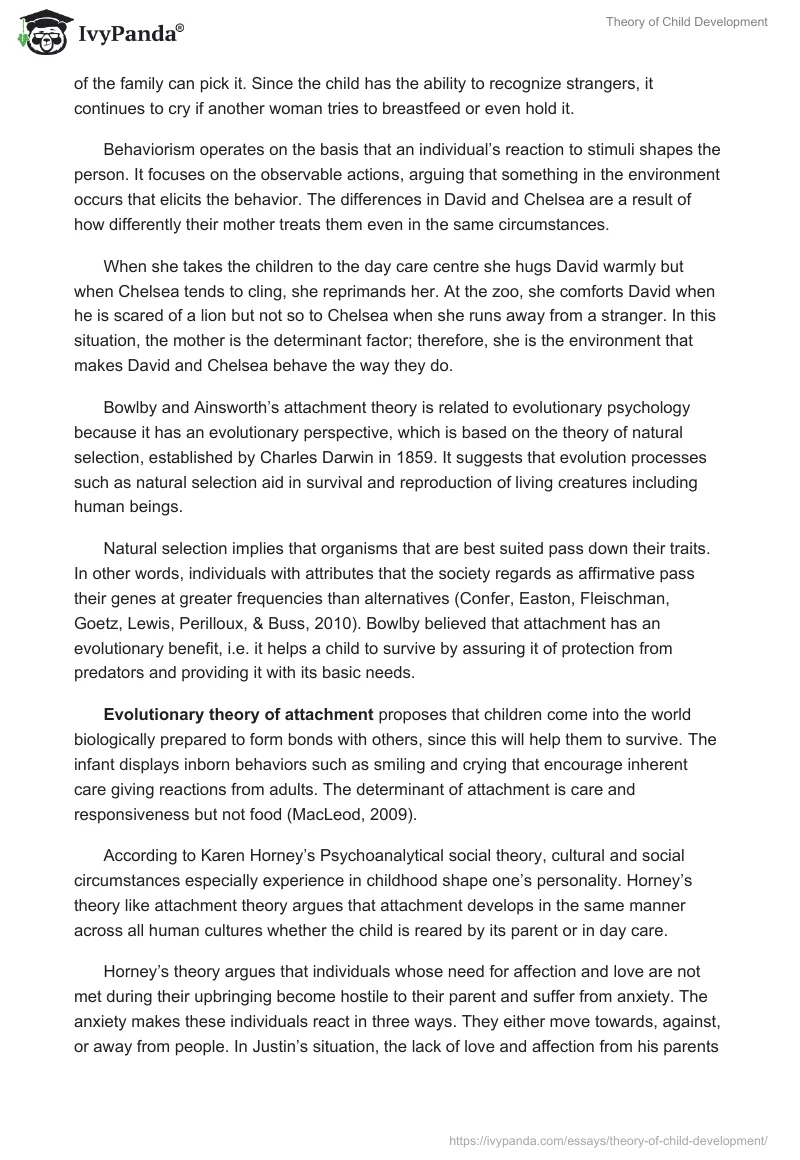The attachment theory is a theory of child development and a creation of the British psychiatrist by the name John Bowlby. According to this theory, children are born in a state of immaturity and have to receive care and protection from adults for many years. Infant mother behavior promotes the survival of a child and becomes a part of all humans through natural selection.
Some of these behaviors include the cry of a child due to hunger or cold; the cry alerts the mother who responds to the infant’s distress. The mother’s actions of responding could include holding, feeding or consoling the infant. These actions comfort the infant and stop its crying and may lead to the baby smiling or laughing. However, if the mother chooses to respond by ignoring the infant, it is bound to continue crying.
Object relations theory argues that interpersonal relations within the family, especially between the child and its mother shape the life or motivate the individual. Object relations theory relates to Bowlby and Ainworth’s attachment theory in the sense that both portray human beings as relationship seeking creatures.
Both theories reveal that a child or individual seeks relationships by identifying with certain objects in order to achieve dependency and/or attachment. In addition, both demonstrate that there can either be positive or negative reinforcement. The two theories contrast because attachment theory starts from birth, when the child performs actions like suckling and crying and continues into adulthood.
However, object relations theory is only applicable when a child gains knowledge. This means that it begins after the infant is a few months old and has the ability to differentiate. We use the example of a new born infant to explain the two theories. When the child is hungry, chances are high that it cries to express the hunger. The mother picks it and breastfeeds it, and it stops crying and tends to play or sleep off due to the satisfaction after feeding.
In addition, if another woman who is not the baby’s mother picks it up and feeds it; the child still feels the satisfaction of being full and reacts in the similar manner that it does with the mother. However, when the child is over six months old, it has the ability to recognize its mother. Therefore, if it cries only the mother or certain close members of the family can pick it. Since the child has the ability to recognize strangers, it continues to cry if another woman tries to breastfeed or even hold it.
Behaviorism operates on the basis that an individual’s reaction to stimuli shapes the person. It focuses on the observable actions, arguing that something in the environment occurs that elicits the behavior. The differences in David and Chelsea are a result of how differently their mother treats them even in the same circumstances.
When she takes the children to the day care centre she hugs David warmly but when Chelsea tends to cling, she reprimands her. At the zoo, she comforts David when he is scared of a lion but not so to Chelsea when she runs away from a stranger. In this situation, the mother is the determinant factor; therefore, she is the environment that makes David and Chelsea behave the way they do.
Bowlby and Ainsworth’s attachment theory is related to evolutionary psychology because it has an evolutionary perspective, which is based on the theory of natural selection, established by Charles Darwin in 1859. It suggests that evolution processes such as natural selection aid in survival and reproduction of living creatures including human beings.
Natural selection implies that organisms that are best suited pass down their traits. In other words, individuals with attributes that the society regards as affirmative pass their genes at greater frequencies than alternatives (Confer, Easton, Fleischman, Goetz, Lewis, Perilloux, & Buss, 2010). Bowlby believed that attachment has an evolutionary benefit, i.e. it helps a child to survive by assuring it of protection from predators and providing it with its basic needs.
Evolutionary theory of attachment proposes that children come into the world biologically prepared to form bonds with others, since this will help them to survive. The infant displays inborn behaviors such as smiling and crying that encourage inherent care giving reactions from adults. The determinant of attachment is care and responsiveness but not food (MacLeod, 2009).
According to Karen Horney’s Psychoanalytical social theory, cultural and social circumstances especially experience in childhood shape one’s personality. Horney’s theory like attachment theory argues that attachment develops in the same manner across all human cultures whether the child is reared by its parent or in day care.
Horney’s theory argues that individuals whose need for affection and love are not met during their upbringing become hostile to their parent and suffer from anxiety. The anxiety makes these individuals react in three ways. They either move towards, against, or away from people. In Justin’s situation, the lack of love and affection from his parents make to react with aggressiveness when his girlfriend Angela feels bothered by his calls and contacts.
His clingy behavior is due to a feeling of rejection and a need for affection and approval. Both theories argue that experiences during childhood have a long lasting influence on an individual’s behavior. The behavior Justin exhibits results from the cold treatment he gets from his parents. He tries to compensate for this by expressing his desperation to be close to Angela.
References
Confer, C. Jaime., Easton, A. Judith., Fleischman, S. Diana., Goetz, D. Cari., Lewis, G. David., Perilloux, Carin., & Buss, M. David. (2010). Evolutionary Psychology: Controversies, Questions, Prospects, and Limitations. In American Psychologist. American Psychological Association, 65(2), 110-126.
McLeod, S. A. (2009). Attachment Theory.Web.


